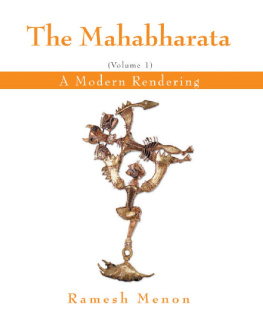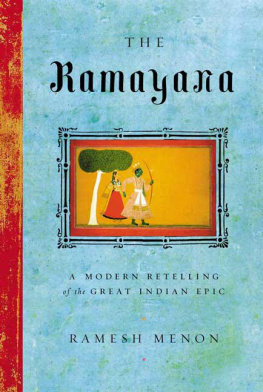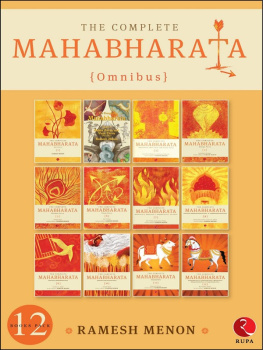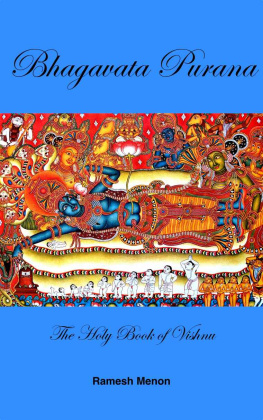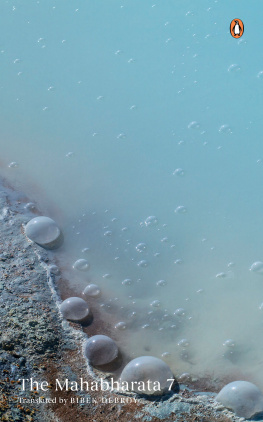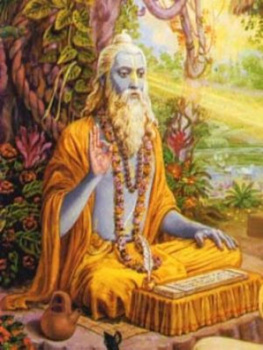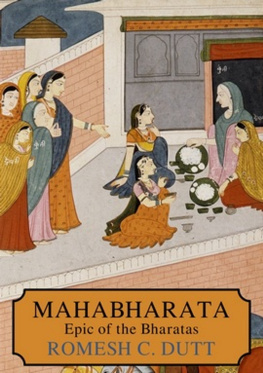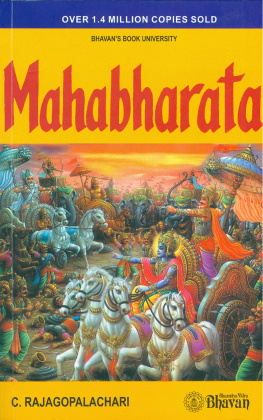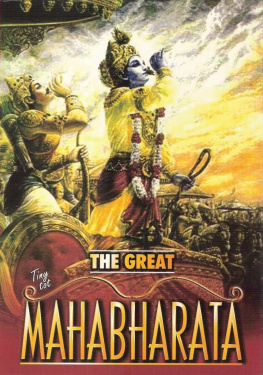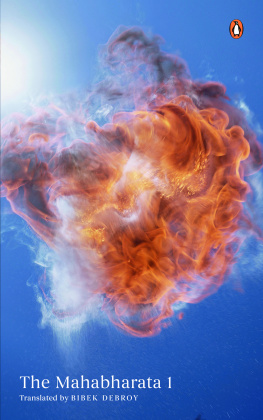THE MAHABHARATA
THE MAHABHARATA
A Modern Rendering
(Volume 1)
Ramesh Menon
iUniverse, Inc.
New York Lincoln Shanghai
THE MAHABHARATA
A Modern Rendering
Copyright 2006 by Ramesh Menon
All rights reserved. No part of this book may be used or reproduced by any means, graphic, electronic, or mechanical, including photocopying, recording, taping or by any information storage retrieval system without the written permission of the publisher except in the case of brief quotations embodied in
critical articles and reviews.
iUniverse books may be ordered through booksellers or by contacting:
iUniverse
2021 Pine Lake Road, Suite 100
Lincoln, NE 68512
www.iuniverse.com
1-800-Authors (1-800-288-4677)
'Memories of a Hero-Stone'
by S. Nandagopal, 2005
Welded Copper & Cast Brass
107 x 64 x 31 cm
Collection: Jasdeep Sandhu. Gajah Gallery, Singapore.
ISBN-13: 978-0-595-40187-1 (pbk)
ISBN-13: 978-0-595-84564-4 (ebk)
ISBN-10: 0-595-40187-2 (pbk)
ISBN-10: 0-595-84564-9 (ebk)
Printed in the United States of America
In memory of my grandparents.
Foreword
A note on Hindu time and the Mahabharata
'Three hundred and sixty-five human years make one year of the Devas and the Pitrs, the Gods and theancestors.
Four are the ages in the land of Bharata: the krita, treta, dwapara and kali. The krita yuga lasts for 4800divine years, the treta for 3600, the dwapara for 2400 and the kali for 1200; and, then, another kritabegins.
The krita or satya yuga is an age of purity; it is sinless. Dharma, righteousness, is perfect and walks on fourfeet in the krita. However, from the treta yuga, adharma, evil, comes to the world and the very fabric oftime begins to decay. Finally, the kali yuga, the fourth age, is almost entirely corrupt, with dharma barelysurviving, hobbling on one foot.
A chaturyuga, a cycle of four ages, is 12,000 divine years, or 365 x 12,000 human years long. Seventy-onechaturyugas make a manvantara; fourteen manvantaras, a kalpa. A kalpa of a thousand chaturyugas, 12million divine years, is one day of Brahma, the Creator.
8,000 Brahma years make one Brahma yuga; 1,000 Brahma yugas make a savana and Brahma's life is3,003 savanas long. One day of Mahavishnu is the lifetime of Brahma'
The Great War, the Mahabharata, is fought at the very end of a dwapara yuga, the third age, just before the sinister kali yuga begins. Once, in time out of mind, the Gods created the kshatriyas to establish dharma, justice, in an anarchic world. Most royal kshatriya bloodlines can be traced back to the Devas themselves: in the most ancient days, the Gods came freely to the earth. But in time, generations, the noble race of warrior kings has grown arrogant and greedy. By the end of the dwapara yuga, they have become tyrants and they are still practically invincible.
Krishna, the Avatara and his cousins, the Pandavas, are born to destroy the power of the kshatriyas of Bharatavarsha (India) forever. This is what the Mahabharata yuddha, the war on the crack of the ages, accomplishes; and thus, ushers in the kali yuga, modern times. By the Hindu calender, the Great War was fought some five thousand years ago.
The House of Kuru is one of the oldest and noblest royal houses. It traces its origins to Soma Deva, the Moon God. Timeless Hastinapura, the city of elephants, is the capital of the Kuru kingdom and one great king after another has ruled from here. The legend of the Mahabharata begins with King Shantanu of the Kurus and how a son is born to him. But that prince, Devavrata, will never sit upon his father's throne. Instead, Shantanu's blind grandson, Dhritarashtra, will become king.
The main theme of the Mahabharata is the story of Dhritarashtra's sons, the Kauravas and his brother Pandu's sons, the Pandavas and the enmity between them. Dhritarashtra's hundred boys are evil princes, led by the eldest of them: the ruthless Duryodhana, who is a demon. Pandu's five princes are Devaputras, Devas' sons, born to fight for dharma in the world.
They are Yudhishtira, Bheema, Arjuna, Nakula and Sahadeva.
Almost every king in Bharatavarsha takes one side or the other in the Great War and ten million kshatriyas are killed. Dharma is established again on earth; but an age has ended and another has begun.
The Maharishi Vyasa, the poet of the Mahabharata, himself wanders in and out of the story. Unearthly beingsDevas, yakshas, gandharvas, nagas and apsarasfind their way into the story, as do demonic ones, asuras and rakshasas. The Mahabharata is set in a pristine and magical time of the earth. Its heroes and villains are all larger than life. The war itself is fought with occult weapons: the astras of the Gods.
Just before the war begins, the third Pandava, Arjuna, the greatest archer in the world, loses his nerve on the field of Kurukshetra. That perfect warrior cannot bear the thought of killing his cousins. Krishna, who is Arjuna's charioteer, expounds the eternal dharma to him. This exposition is the Bhagavad Gita, the Song of God. The Gita is the heart of the Mahabharata, its real treasure. At one level, all the rest of the restless action of the epic is a quest for the precious Gita and its stillness. The Gita is the Hindu's New Testament.
Senayor ubhayor madhyebetween two immense armies, on the brink of a savage war, the Avatara sings his wisdom. To this day, Kurukshetra is holy ground for the Hindu because it was here that Krishna sang his immortal Gita and here that he revealed his Viswarupa, his Cosmic Form, to Arjuna.
The original Mahabharata in Sankrit is an epic poem of 100,000 couplets: seven times as long as the Iliad and the Odyssey combined. To record his epic for posterity is such a daunting task that Vyasa begs the elephant-headed God, Ganesha, to be his scribe. Ganesha has one stipulation: Vyasa must never keep him waiting, for even a moment, during the narration. The poet agrees and manages to keep ahead of his quicksilver writer, often with long digressions from his main story. Ganesha writes down Vyasa's legend with a tusk he breaks from his own face.
This is a modern prose version of Vyasa's timeless epic: the legend of the sons of Pandu.
Acknowledgements
The late Kamala Subramaniam's Mahabharata in English was one of my main sources for this version of the epic. Her devotion was exceptional and my debt to her is great.
After finishing my book, I discovered Kisari Mohan Ganguli's 12 volume translation. I have added some details from his work, which I found interesting and relevantas footnotes, to the text of my book and in an Appendix.
I must thank Vasantha Menon, Jayashree Kumar, Saugata Mukherjee and Atreyee Gohain, for their wonderful copyediting and my Indian Publisher, Mr. RK Mehra of Rupa Books, for his personal interest and support.
Preface
THE BIRTH OF A POET
Once, in more gracious times, when the kshatriyas of the earth were like gods, there was a devout sovereign of Chedi called Uparichara. Indra of the Devas gave him a marvelous vimana, a crystal ship that flew anywhere at his very thought. That king became known as Uparichara Vasu; for like the Vasus, he ranged the sky in his vimana.
Uparichara's wife was Girika and she bore him five excellent princes. One morning, when she was in her fertile time, queen Girika came to her husband and asked him to make love because she wanted another son. But today he had promised to go into the forest to hunt some meat for a sacrifice to his fathers in heaven. Uparichara set out with his bow in his hand.
Next page
